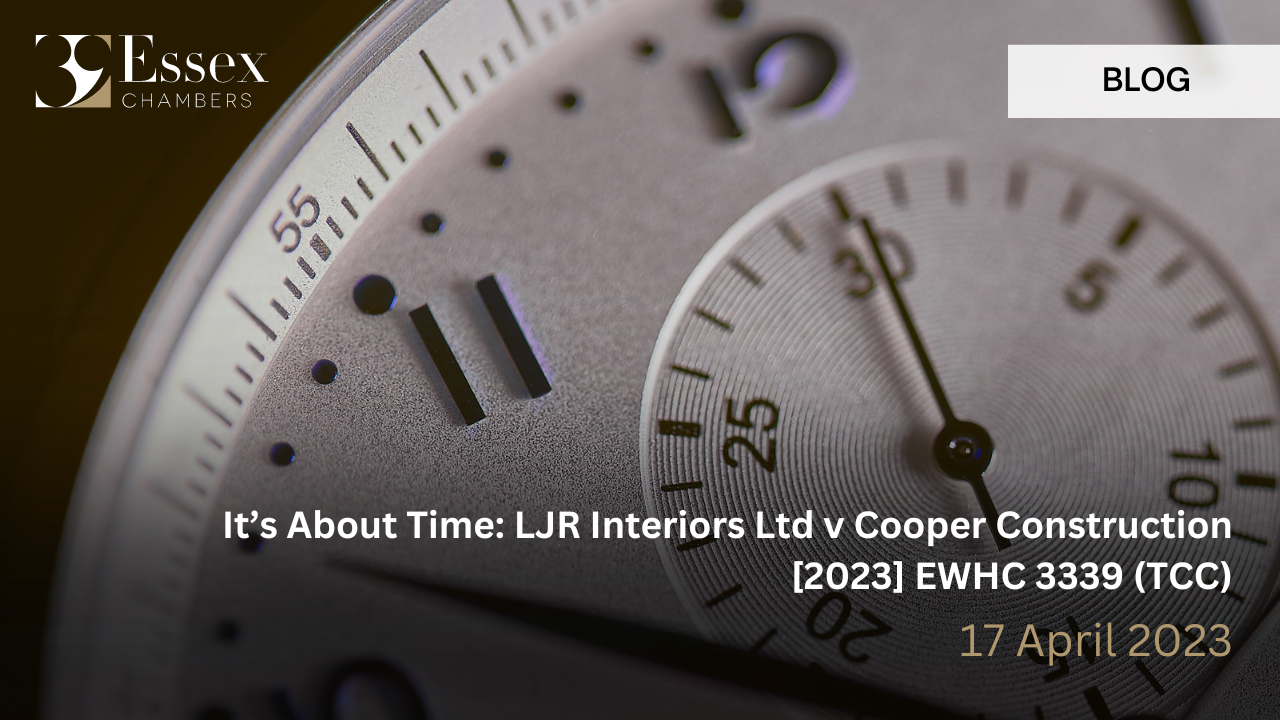It’s About Time: LJR Interiors Ltd v Cooper Construction [2023] EWHC 3339 (TCC)
 The High Court’s judgment in LJR Interiors Ltd v Cooper Construction [2023] EWHC 3339 (TCC) is important, not only because of its discussion of the application of the Limitation Act 1980 (“the Act”) to adjudication proceedings (albeit this discussion is subject to a significant health warning), but also because it creates some doubt about when the clock starts running for limitation purposes.
The High Court’s judgment in LJR Interiors Ltd v Cooper Construction [2023] EWHC 3339 (TCC) is important, not only because of its discussion of the application of the Limitation Act 1980 (“the Act”) to adjudication proceedings (albeit this discussion is subject to a significant health warning), but also because it creates some doubt about when the clock starts running for limitation purposes.
The Facts
In August 2014, the parties entered into a written contract under which LJR agreed to carry out dry lining, plastering and screed works for Cooper at a property in Oxfordshire. The quote was for £18,675 plus VAT. The works were completed on 19 October 2014.
On 31 July 2022, almost eight years after it had finished the works, LJR submitted Application No 4. This was in the sum of £3,256.58 excluding VAT. Cooper did not respond to Application No 4, either by paying it or by issuing a pay less notice.
On 9 September 2022, LJR gave notice of intention to refer a dispute under Application No 4 to adjudication.
The adjudicator found that:
- Application No 4 was a valid application for payment.
- No pay less notice had been served by Cooper.
- With regard to limitation, the breach alleged by LJR was the failure to make payment of a sum claimed due by the final date for payment, namely 28 August 2022. On that basis, the limitation period pursuant to Section 5 of the Act had not yet expired.
LJR issued a Part 7 claim to enforce the adjudicator’s decision. Cooper issued a Part 8 claim seeking a declaration that the adjudicator’s decision was void and unenforceable as the sum awarded in LJR’s favour by the adjudicator was barred by limitation. Notably, LJR was not legally represented at the hearing.
The Judgment
Section 5 of the Act provides: “An action founded on simple contract shall not be brought after the expiration of 6 years from the date on which the cause of action accrued”. The question was: are adjudication proceedings an “action” within the meaning of Section 5?
The Judge, HHJ Russen KC, found that they are:
- Amongst other authorities, he pointed to Connex South Eastern Limited v M J Building Services Group PLC [2005] EWCA Civ 193, where Lord Dyson said: “…there is nothing to prevent a party from referring a dispute to adjudication at any time, even after the expiry of the relevant limitation period…Just as a party who takes that course in court proceedings runs the risk that, if the limitation defence is pleaded, the claim will fail (and indeed may be struck out), so a party who takes that course in adjudication runs the risk that, if the limitation defence is taken, the adjudicator will make an award in favour of the respondent” (paragraph 39).
- The dicta in Connex and other authorities reinforced the “almost instinctive response” that it is difficult to identify a good reason why a limitation defence should not, like any other defence to a payment obligation, form part of a dispute to be referred to adjudication (paragraph 61).
- That is particularly so when adjudication decisions often lead to court proceedings in the form of enforcement.
- If adjudication decisions did not recognise limitation defences, a party would, through the grafting on of the discrete limitation period which applies to any action to enforce the decision, benefit from a much longer limitation period than Section 5 contemplates for the bringing of legal proceedings.
If he was wrong on that, the Judge found that the Court was required to consider the limitation defence in the action before it, i.e. the Part 8 claim.
In relation to the limitation period applicable to Application No 4, the Judge found that:
- The contract provided an adequate mechanism for payment. LJR was to submit invoices for stage payments based on the value of the work performed and the relevant payment would fall due 28 days after the date of the invoice (paragraph 78).
- Application No 4 was a claim for sums which had, in the main, already been claimed in Application No 3, which was made on 31 October 2014. The right to payment of all sums identified in Application No 4 which matched those in Application No 3 accrued on 28 November 2014, 28 days after the invoice for Application No 3 was submitted.
- If the Judge was wrong, and the contract did not provide an adequate mechanism for payment and so the Scheme for Construction Contracts (England and Wales) Regulations 1998 (“the Scheme”) applied: (a) the due date was 30 November 2014 (under paragraph 5 of Part II of the Scheme); and (b) the final date for payment was 17 December 2014 (under paragraph 8(2) of the Scheme).
- Either under the terms of the contract or under the Scheme, LJR’s claim under Application No 4 for sums which had already been sought in Application No 3 was statute barred by limitation when it was referred to adjudication. The Judge dealt separately with an administration charge which had not been claimed in Application No 3, which he also found was statute barred.
- The adjudicator’s decision was clearly wrong and was unenforceable.
Interesting Points
In my view, there are a number of interesting points about the Judgment.
Health warning
First, the Judge’s conclusions on the applicability of the Act were subject to an important health warning: they “…should be read with the caution that they are largely the product of my own thoughts and therefore lack the firmer footings usually provided by full adversarial argument” (paragraph 15).
Parties may try to use this health warning to persuade future judges not to follow this decision.
Merits-Based Decision?
Secondly, I can see why, on the merits, adjudication proceedings should be subject to the Act. The Judge described Application No 4 as a “return to an otherwise cold contractual scene long after the time when any appropriate investigations into it might be expected to have concluded” (paragraph 48). The prospect of such adjudications would increase the uncertainty for all parties involved in construction projects, as they may be issued many years after the works are completed.
However, the legal analysis to get to that result is difficult. Adjudication proceedings do not fit happily within the definition of an “action” within Section 38 of the Act. The scope of the Act has been expressly extended to cover arbitral proceedings, but there is no express extension for adjudication.
The Judge was comforted by the fact that, even if the Act did not apply to adjudication, it would apply to enforcement. It is not immediately obvious how this would work. If the adjudication proceedings themselves were not subject to the Act, resisting enforcement on the grounds that the underlying claim would have been statute barred if litigation had been commenced would involve an extension of the grounds on which enforcement can be resisted. However: (a) there would be benefits to dealing with limitation on enforcement rather than during the adjudication (such as allowing parties who have entered standstill agreements in relation to litigation but not adjudication to commence an adjudication); and (b) dealing with limitation on enforcement would avoid the need to shoehorn adjudication proceedings into an “action” within the meaning of the Act.
When does the clock start running?
The Judge’s reasoning assumes that the cause of action accrued on the due date (28 November 2014, if the contract applies) or the final date for payment (17 December 2014, if the contract does not provide an adequate mechanism for payment and the Scheme applies).
However, in Hirst v Dunbar [2022] EWHC 41 (TCC), the Court noted that the starting point is that the right to payment arises when the work in question is completed and it is a question of construction whether the terms of a particular agreement produce a different result (paragraph 100). The Court in Hirst found that a payment notice under the Scheme is not a precondition for payment: it is “concerned with the process of billing and payment not the question of when the Claimants’ entitlement to payment arose” (paragraph 117). The payment notice had no relevance to when the Claimants’ cause of action accrued, and the limitation period ran from when the works were completed. Hirst has since been followed, albeit not in a construction case, in Consulting Concepts International v Consumer Protection Association [2022] EWHC 461 (Comm).
The Judge in LJR does not seem to have been referred to Hirst. That, together with the fact that one of the parties was not represented in LJR and that Hirst was followed in Consulting Concepts, suggests to me that Hirst is more likely to be followed in the future. However, whilst there is uncertainty regarding when the clock starts running for limitation purposes, it would be safest to work to the earliest possible date.
Practicalities
Finally, the Judge reiterated the important practical point that, where a Part 8 claim is made alongside a Part 7 claim for summary judgment, the parties need to address their minds to an appropriate time estimate. The court will be unimpressed if it transpires that the time estimate is inadequate.

